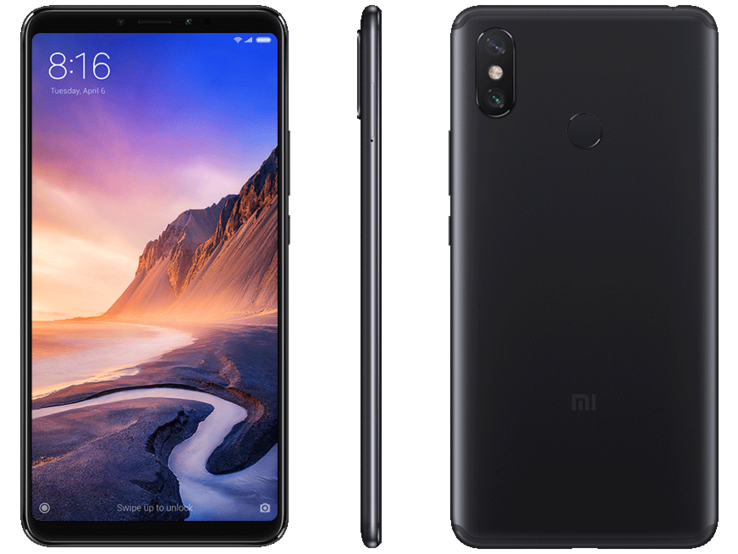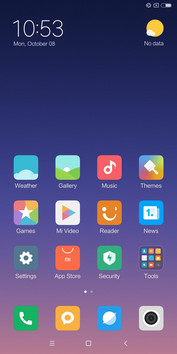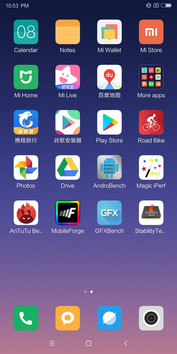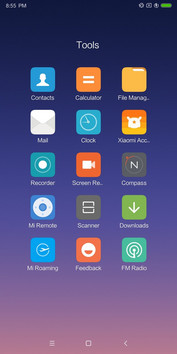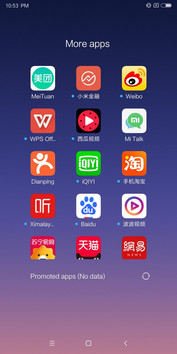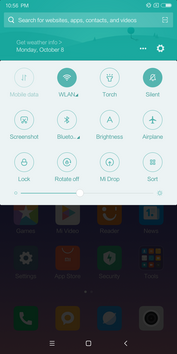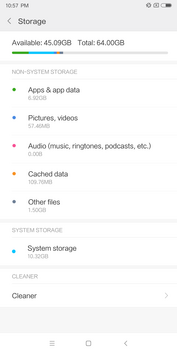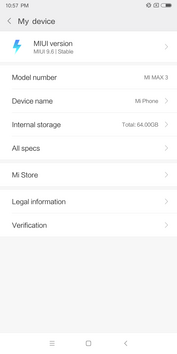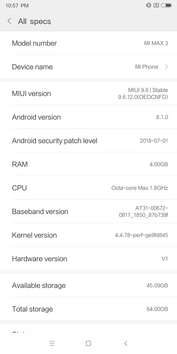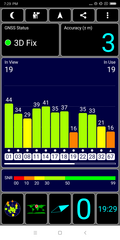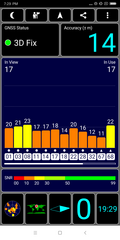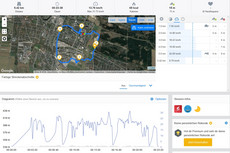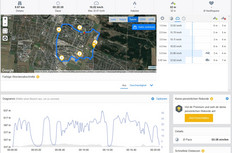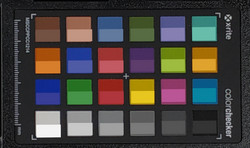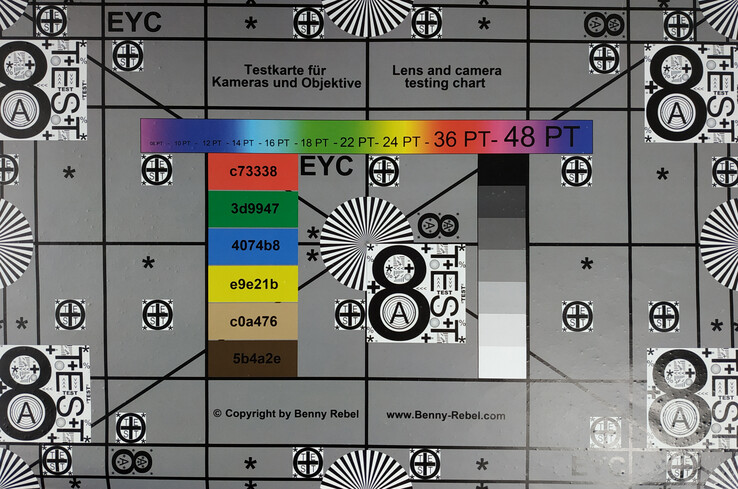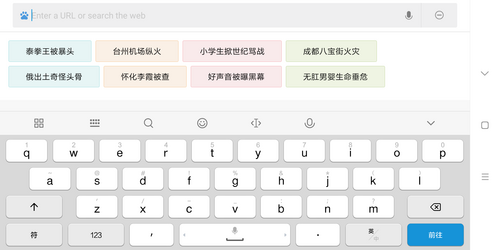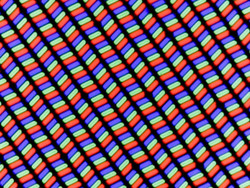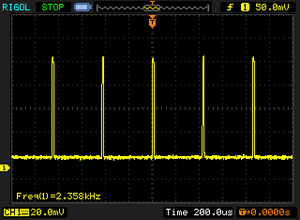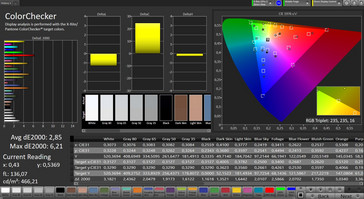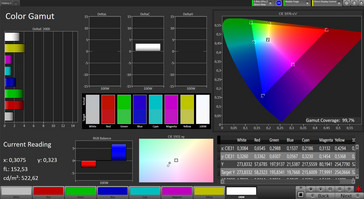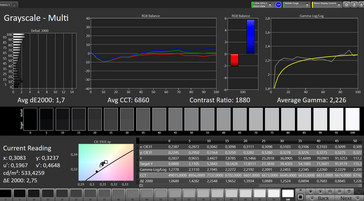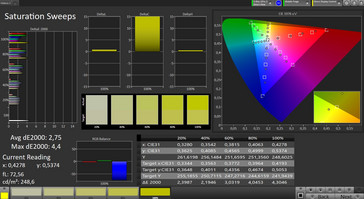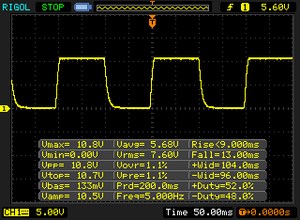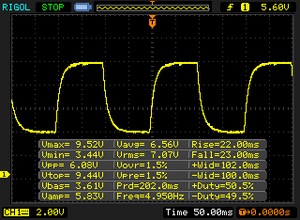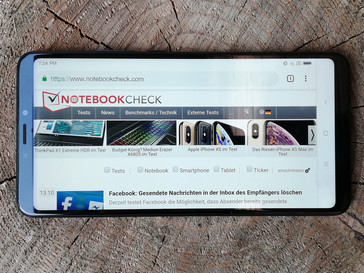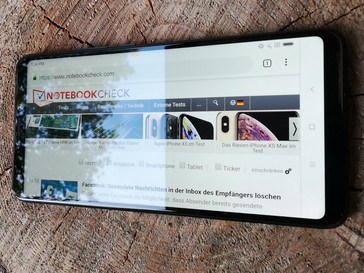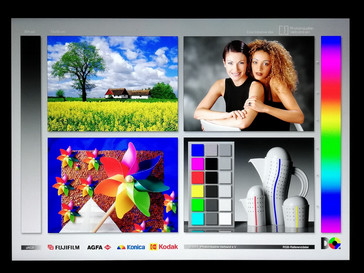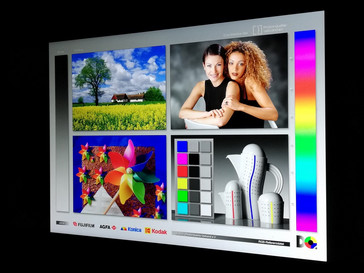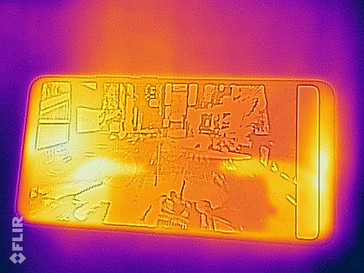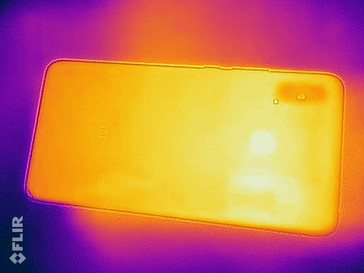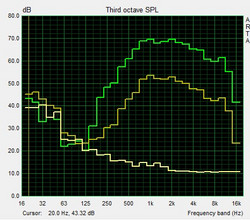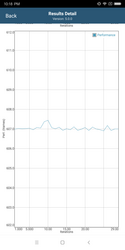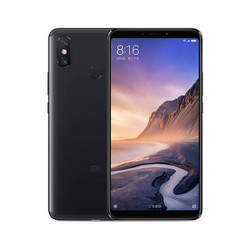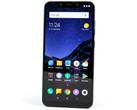Xiaomi Mi Max 3 Smartphone Review
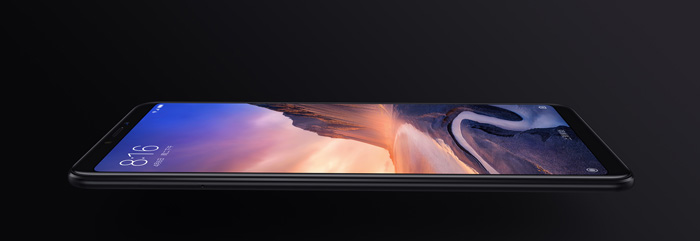
Xiaomi has improved the successor of the Mi Max 2 in many places and now offers an even larger mid-range phablet to buyers. There is a Qualcomm Snapdragon 636 SoC inside, which is supported in its work by an Adreno 509 graphics unit. While our test unit offers 4 GB of RAM and 64 GB of eMMC flash storage, supposedly there will also be a model variant with 6 GB of RAM and 128 GB of data storage.
With its size of 6.9 inches, the Mi Max 3 is a very large Android phablet that can only be compared to smaller devices in our test. Their size is at least 6 inches, and their price and performance are similar. In this test, we include the Sony Xperia XA2 Plus, the Honor Play, the JVC J20, and the Asus ZenFone 5 (2018) as smartphones from competitors.
Case - Sturdy smartphone with a metal case
The case of the Xiaomi Mi Max 3 is made of metal and offers a good grip due to its very rounded edges. Since the display sticks out above the body by about 1 mm (~0.04 in), it looks as if it was placed on top of the base, but it still fits well into the overall appearance. The transitions between the materials fit tightly and show very good workmanship. Buyers of the Xiaomi phablet have the choice between black, blue, and gold case colors.
On the right side of the case are the power button and volume rocker; they have a slight play in their frames. The nano-SIM/microSD card tray sits tightly in its slot. The dual camera system on the back sticks out slightly from the case, and the fingerprint sensor is located in the center of the upper third of the case.
In the size and weight comparisons, the Xiaomi smartphone sticks out significantly in our comparison chart but is also slightly slimmer, and it is not as fat as the Sony Xperia XA2 Plus, for example.
Equipment - The Xiaomi smartphone with USB Type-C
Buyers of the Mi Max 3 receive a mid-range phablet that is run by a Qualcomm Snapdragon 636 SoC with an Adreno 509 graphics unit, 4 GB of RAM, and 64 GB of eMMC flash storage. The internal storage can be expanded via microSD card, but then users will have to make do without the dual-SIM function. There is a 3.5 mm audio port to connect external devices, and you can charge the Android smartphone via a USB Type-C port. While this is only connected via the USB-2.0 standard, it still supports OTG functions such as charging external devices.
The Xiaomi Mi Max 3 also has an infrared sensor that can be setup to control various multimedia devices via the Mi-Remote app. In this way, the remote control of your TV can be replaced by the Android phablet.
Software - Chinese smartphone with an English menu
The Mi Max 3 has Android Oreo version 8.1 with security updates on the level of July 1, 2018. Xiaomi uses its own in-house MIUI 9.6 user interface, which is mainly characterized by its adjusted sorting of the Settings menu and many apps by the manufacturer. You can easily uninstall apps in the menu that are not relevant for system operation.
Since our test unit is an imported device, there are many Chinese apps preinstalled. Furthermore, the Xiaomi phablet is delivered to Europe with an adjusted ROM, requiring users to install the various Google apps from the Play Store themselves, if they want to use them. While this process works without a hitch, it may deter some inexperienced users. In addition, there is the constant "online hunger" that often shows during the operation of the Android phablet. For example, you have to be online if you want to allow the file manager to install programs. Interested buyers should also consider that the menus of the Xiaomi Mi Max 3 are in English. In contrast, the version for the local market that is also already available of course supports all the local languages.
Communication and GPS - Xiaomi Mi Max 3 with ac WLAN
The Xiaomi Mi Max 3 is able to create mobile connections with the GSM, 3G, and LTE networks. The latter is possible with LTE Category 12, which allows download speeds of up to 600 Mb/s and upload speeds of up to 100 Mb/s. The Android phablet can be used globally and also offers the LTE Band 20 that is still important in Germany.
For close-up wireless data transfer, Bluetooth version 5.0 and WLAN with the fast ac standard are available to the users of the Xiaomi phablet. In our WLAN test, the Mi Max 3 is able to leave the competitors behind in terms of data reception, achieving a fast 344 Mb/s. However, when sending data it is only sufficient for a place in the middle of our comparison list, reaching 265 Mb/s.
| Networking | |
| iperf3 transmit AX12 | |
| Sony Xperia XA2 Plus | |
| Asus Zenfone 5 ZE620KL | |
| Xiaomi Mi Max 3 | |
| JVC J20 | |
| Honor Play | |
| iperf3 receive AX12 | |
| Xiaomi Mi Max 3 | |
| Asus Zenfone 5 ZE620KL | |
| Sony Xperia XA2 Plus | |
| JVC J20 | |
| Honor Play | |
We test how accurately the Xiaomi Mi Max 3 can determine our location using the GPS Test app. Outdoors, it can locate us with an accuracy of up to 3 m (~10 ft). Indoors, the Android phablet is also able to create a satellite connection and locates our position with an accuracy of up to 14 m (~46 ft).
On our mandatory bike tour, we compare the Mi Max 3 with our Garmin Edge 520 reference device. During long straight runs, the recorded route of the Xiaomi phablet lies only slightly apart from the actual route. In tight turns and longer curves however, the recordings become increasingly inaccurate, some turns are just left out in parts, being replaced merely with straight lines across the surrounding objects. The Mi Max 3 is therefore only suited for simple navigation tasks.
Telephone Functions and Voice Quality - A good connection with the Mi Max 3
There is only a simple app to make phone calls for users of the Mi Max 3. It offers two tabs on the Xiaomi phablet, allowing you to either input numbers directly, or select contacts from the address book. During a phone conversation, the smartphone presents itself as very balanced. The conversation partner is transferred in an easily understandable manner, and background noises are filtered out to some extent. While the volume is okay, it is unable to ensure clear communication on high-traffic roads, for example.
The Mi Max 3 supports VoLTE as long as this option is offered by your provider.
Cameras - Android smartphone with dual camera system
The Mi Max 3 offers a 12+5 MP dual camera system with an f/1.9 aperture on the back and an 8 MP front camera with an f/2.0 aperture. With the latter, you can take portrait pictures of mediocre quality. While the details are reproduced well in the foreground and background, there is some very coarse graininess even without the zoom. This prevents color transitions from appearing cleanly and blends light and dark areas together, instead of them remaining separated. In Portrait mode, you can influence the image by adjusting the skin tone, eye size, or width of the chin, for example.
The main camera of the Mi Max 3 is well-suited for the occasional panorama picture. Large brightness differences only cause limited problems for the Xiaomi phablet. In dark image areas, details remain recognizable and can be distinguished from other objects. The whole image offers many details, although they become slightly blurry when zooming in. In close-ups, this blurriness even occurs with objects that remain outside the focal range. Even though this effect is only slight, it is still noticeable.
Colors appear saturated, and light and dark areas are well delineated in the image here as well. Details also remain recognizable. However, at the edges of the images there is some slight graininess that can only be seen when zooming in. Under bad light conditions, objects in the image barely remain recognizable, with large areas of the image becoming black. You can adjust the values for white balance, ISO, shutter speed, and focus via a manual photo mode to influence the image quality.
Video-recordings with the Xiaomi smartphone produce a similar result as our example pictures. An image stabilizer compensates for smaller movements. While the camera app of the Mi Max 3 does not offer a professional mode for videos or something similar, there is a Time Shift and a Time Lapse mode.
Using the ColorChecker passport, we evaluate the color reproduction of the Mi Max 3 camera. It shows here that colors are reproduced too dark through the bank. Gray and black tones are also darker than they should be.
Under controlled light conditions, the camera of the Xiaomi smartphone is able to reproduce our test chart well. Fine structures and details remain recognizable. However, even at a low zoom level, they become slightly blurry. Colors appear moderate, and there is a slight paleness at the left edge of the image.
Accessories and Warranty - Chinese import with a warranty
The box of the Xiaomi Mi Max 3 includes a SIM tool, a USB charger with a US plug and the corresponding USB Type-C cable. Our import version from TradingShenzen also included the corresponding EU adapter.
Xiaomi offers a warranty of 24 months to buyers of the Mi Max 3. In the case of the vendor who loaned us the device, this can be handled directly by the vendor. Please see our Guarantees, Return policies and Warranties FAQ for country-specific information.
Input Devices and Operation - Mi Max 3 with a precise touchscreen
For text input, the Mi Max 3 has the Beidu-IME keyboard, which offers the option to input text in Chinese or English. In browser and messenger input fields, the English version is available most of the time. However, during games it happened occasionally that we were presented with the variant optimized for Chinese characters. The touchscreen offers a smooth surface and responds reliably to touch in any part of the screen.
Using the fingerprint sensor on the back, the Xiaomi smartphone can be unlocked quickly. The response time is very brief, and the stored fingerprints are recognized reliably.
Display - Xiaomi smartphone with a bright display
The screen of the Xiaomi Mi Max 3 is a 6.9-inch IPS panel that offers a resolution of 2160x1080 pixels. At an average of 505 cd/m², the offered brightness places it in the middle of the field of comparable devices, and the brightness distribution of 91% places it even slightly above. Considering all the characteristics of the panel, the Xiaomi Mi Max 3 offers the best display among the competitors we selected.
| |||||||||||||||||||||||||
Brightness Distribution: 91 %
Center on Battery: 508 cd/m²
Contrast: 1814:1 (Black: 0.28 cd/m²)
ΔE ColorChecker Calman: 2.85 | ∀{0.5-29.43 Ø4.78}
ΔE Greyscale Calman: 1.7 | ∀{0.09-98 Ø5}
99.7% sRGB (Calman 2D)
Gamma: 2.226
CCT: 6860 K
| Xiaomi Mi Max 3 IPS, 2160x1080, 6.9" | Sony Xperia XA2 Plus IPS, 2160x1080, 6" | Honor Play IPS, 2340x1080, 6.3" | JVC J20 IPS, 2160x1080, 5.7" | Asus Zenfone 5 ZE620KL IPS, 2246x1080, 6.2" | |
|---|---|---|---|---|---|
| Screen | -6% | -31% | -134% | -41% | |
| Brightness middle (cd/m²) | 508 | 597 18% | 435 -14% | 411 -19% | 595 17% |
| Brightness (cd/m²) | 505 | 592 17% | 426 -16% | 426 -16% | 561 11% |
| Brightness Distribution (%) | 91 | 92 1% | 89 -2% | 82 -10% | 87 -4% |
| Black Level * (cd/m²) | 0.28 | 0.32 -14% | 0.39 -39% | 0.53 -89% | 0.54 -93% |
| Contrast (:1) | 1814 | 1866 3% | 1115 -39% | 775 -57% | 1102 -39% |
| Colorchecker dE 2000 * | 2.85 | 2.4 16% | 2.89 -1% | 8.84 -210% | 4.2 -47% |
| Colorchecker dE 2000 max. * | 6.21 | 5.3 15% | 6.03 3% | 15.08 -143% | 6 3% |
| Greyscale dE 2000 * | 1.7 | 3.4 -100% | 4.1 -141% | 10.7 -529% | 4.7 -176% |
| Gamma | 2.226 99% | 2.2 100% | 2.251 98% | 2.433 90% | 2.12 104% |
| CCT | 6860 95% | 7172 91% | 7408 88% | 10717 61% | 7577 86% |
* ... smaller is better
Screen Flickering / PWM (Pulse-Width Modulation)
| Screen flickering / PWM detected | 2358 Hz | ≤ 10 % brightness setting | |
The display backlight flickers at 2358 Hz (worst case, e.g., utilizing PWM) Flickering detected at a brightness setting of 10 % and below. There should be no flickering or PWM above this brightness setting. The frequency of 2358 Hz is quite high, so most users sensitive to PWM should not notice any flickering. In comparison: 53 % of all tested devices do not use PWM to dim the display. If PWM was detected, an average of 8111 (minimum: 5 - maximum: 343500) Hz was measured. | |||
Our measurements also attest the display of the Mi Max 3 with a very good contrast ratio of 1814:1 and a good black value of 0.28 cd/m². This causes the colors to appear clearly separated from each other, and black tones are only covered by a very slight gray veil.
However, the CalMAN analysis also shows a slightly elevated blue tint. This can be remedied by an adjustment of the color temperature in the Settings menu. To do this, you can either use some preset modes or a color scale for manual adjustments.
Display Response Times
| ↔ Response Time Black to White | ||
|---|---|---|
| 22 ms ... rise ↗ and fall ↘ combined | ↗ 9 ms rise | |
| ↘ 13 ms fall | ||
| The screen shows good response rates in our tests, but may be too slow for competitive gamers. In comparison, all tested devices range from 0.1 (minimum) to 240 (maximum) ms. » 47 % of all devices are better. This means that the measured response time is similar to the average of all tested devices (20.2 ms). | ||
| ↔ Response Time 50% Grey to 80% Grey | ||
| 45 ms ... rise ↗ and fall ↘ combined | ↗ 22 ms rise | |
| ↘ 23 ms fall | ||
| The screen shows slow response rates in our tests and will be unsatisfactory for gamers. In comparison, all tested devices range from 0.165 (minimum) to 636 (maximum) ms. » 76 % of all devices are better. This means that the measured response time is worse than the average of all tested devices (31.6 ms). | ||
The Xiaomi Mi Max 3 can be used easily outdoors. The brightness is sufficient to still recognize the image content in brighter surroundings. There are only moderate reflections of the surrounding objects. However, in direct sunlight it becomes increasingly difficult to read the display content.
The viewing angles of the Mi Max 3 IPS panel are very stable, so you can read the content on the screen from almost any direction. As long as there are no reflections hindering the view of the display, the Xiaomi phablet can also be used from unusual positions.
Performance - The Xiaomi Mi Max 3 produces a good performance
In the Mi Max 3, Xiaomi uses the Qualcomm Snapdragon 636 SoC and an integrated Adreno 509 graphics unit. Together with 4 GB of RAM and 64 GB of eMMC flash storage, users receive solid mid-range equipment, allowing them to run many everyday applications.
With these hardware components, the Xiaomi phablet places exactly in the middle of the comparison field. The offered performance is at the level of comparable devices with the Snapdragon 636 SoC and is very balanced across all the disciplines of CPU, storage, and graphics.
| AnTuTu v6 - Total Score (sort by value) | |
| Xiaomi Mi Max 3 | |
| Sony Xperia XA2 Plus | |
| Honor Play | |
| JVC J20 | |
| Asus Zenfone 5 ZE620KL | |
| Average Qualcomm Snapdragon 636 (92015 - 125213, n=10) | |
| AnTuTu v7 - Total Score (sort by value) | |
| Xiaomi Mi Max 3 | |
| Sony Xperia XA2 Plus | |
| Honor Play | |
| JVC J20 | |
| Asus Zenfone 5 ZE620KL | |
| Average Qualcomm Snapdragon 636 (115565 - 138661, n=11) | |
| PCMark for Android - Work performance score (sort by value) | |
| Xiaomi Mi Max 3 | |
| Sony Xperia XA2 Plus | |
| Honor Play | |
| JVC J20 | |
| Asus Zenfone 5 ZE620KL | |
| Average Qualcomm Snapdragon 636 (6040 - 7618, n=11) | |
| GFXBench 3.1 | |
| on screen Manhattan ES 3.1 Onscreen (sort by value) | |
| Xiaomi Mi Max 3 | |
| Sony Xperia XA2 Plus | |
| Honor Play | |
| JVC J20 | |
| Asus Zenfone 5 ZE620KL | |
| Average Qualcomm Snapdragon 636 (5.7 - 12, n=12) | |
| Average of class Smartphone (11 - 166, n=158, last 2 years) | |
| 1920x1080 Manhattan ES 3.1 Offscreen (sort by value) | |
| Xiaomi Mi Max 3 | |
| Sony Xperia XA2 Plus | |
| Honor Play | |
| JVC J20 | |
| Asus Zenfone 5 ZE620KL | |
| Average Qualcomm Snapdragon 636 (6.3 - 10, n=12) | |
| Average of class Smartphone (8.4 - 413, n=158, last 2 years) | |
In the browser benchmarks, the Mi Max 3 also offers balanced results. While its performance places it in the middle of our comparison field again, it always remains slightly below the performance achieved by other smartphones with the Qualcomm Snapdragon 636 SoC. In everyday life, the Xiaomi phablet ensures fast page loads and also makes media content available quickly.
| JetStream 1.1 - Total Score | |
| Asus Zenfone 5 ZE620KL (Chrome 67) | |
| Average Qualcomm Snapdragon 636 (44.2 - 51.5, n=11) | |
| Xiaomi Mi Max 3 (Chrome 69) | |
| Honor Play (Chrome 68) | |
| JVC J20 (Chrome 68) | |
| Sony Xperia XA2 Plus (Chrome 67) | |
| Octane V2 - Total Score | |
| Average of class Smartphone (2228 - 121337, n=201, last 2 years) | |
| Asus Zenfone 5 ZE620KL (Chrome 67) | |
| Average Qualcomm Snapdragon 636 (8163 - 9746, n=12) | |
| Xiaomi Mi Max 3 (Chrome 69) | |
| Honor Play (Chrome 68) | |
| JVC J20 (Chrome 68) | |
| Sony Xperia XA2 Plus (Chrome 67) | |
| Mozilla Kraken 1.1 - Total | |
| Sony Xperia XA2 Plus (Chrome 67) | |
| JVC J20 (Chrome 68) | |
| Honor Play (Chrome 68) | |
| Average Qualcomm Snapdragon 636 (4105 - 5066, n=12) | |
| Xiaomi Mi Max 3 (Chrome 69) | |
| Asus Zenfone 5 ZE620KL (Chrome 67) | |
| Average of class Smartphone (257 - 28190, n=156, last 2 years) | |
| WebXPRT 2015 - Overall | |
| Average Qualcomm Snapdragon 636 (147 - 184, n=8) | |
| Xiaomi Mi Max 3 (Chrome 69) | |
| Honor Play (Chrome 68) | |
| Sony Xperia XA2 Plus (Chrome 67) | |
* ... smaller is better
The results of the storage benchmarks also place the Mi Max 3 in the middle of the field of comparison devices. The achieved values attest the Xiaomi smartphone with a good storage performance that has access rates that do not cause any noticeable delays. Of the 64 GB eMMC flash storage, users still have about 50 GB available to store their own applications and data. The storage can be expanded via the internal microSD card reader. However, this can only be used for data. Apps cannot be moved onto the microSD card and it cannot be formatted as internal storage either.
| Xiaomi Mi Max 3 | Sony Xperia XA2 Plus | Honor Play | JVC J20 | Asus Zenfone 5 ZE620KL | Average 64 GB eMMC Flash | Average of class Smartphone | |
|---|---|---|---|---|---|---|---|
| AndroBench 3-5 | -15% | 70% | -17% | 3% | -15% | 548% | |
| Sequential Read 256KB (MB/s) | 274.6 | 281.1 2% | 895 226% | 270.6 -1% | 286.6 4% | 277 ? 1% | 2223 ? 710% |
| Sequential Write 256KB (MB/s) | 185.4 | 146.2 -21% | 188.3 2% | 199.7 8% | 201.8 9% | 178.4 ? -4% | 1838 ? 891% |
| Random Read 4KB (MB/s) | 72.9 | 77.4 6% | 142.4 95% | 58.3 -20% | 71.2 -2% | 60.7 ? -17% | 295 ? 305% |
| Random Write 4KB (MB/s) | 87.1 | 10.5 -88% | 155.5 79% | 6.3 -93% | 83.5 -4% | 33.8 ? -61% | 335 ? 285% |
| Sequential Read 256KB SDCard (MB/s) | 83.8 ? | 86 ? 3% | 82.8 ? -1% | 82.8 ? -1% | 85.8 ? 2% | 77.4 ? -8% | |
| Sequential Write 256KB SDCard (MB/s) | 60.3 ? | 67 ? 11% | 71.9 ? 19% | 63 ? 4% | 65.2 ? 8% | 58.3 ? -3% |
Games - Gaming-capable phablet from Xiaomi
The Xiaomi Mi Max 3 is quite suitable for gaming. The internal Adreno 509 graphics unit from Qualcomm is able to display most games smoothly. However, in graphically very-demanding applications, you have to make do with low graphics settings and expect longer load times. The large screen shows games to their best advantage, and the operation does not suffer from the large format.
The touchscreen responds to touch directly and offers only slight resistance to the fingertips, so that there are no problems even after longer gaming sessions. The position sensor transmits movements directly to the smartphone, causing them to be translated into the game without any longer delays.
Emissions - A cool Android smartphone
Temperature
In our test, the temperatures on the surface of the Mi Max 3 reach barely above 27 °C (81 °F) during idle and up to 32 °C (90 °F) under load. With this, the Xiaomi smartphone only warms up moderately and can be held comfortably in the hand at all times.
The demanding Manhattan 3.1 test of GFXBench also shows that the performance does not drop over longer periods of time. Thus we do not expect any limitations due to high temperatures in the operation of the Xiaomi Mi Max 3.
(+) The maximum temperature on the upper side is 32.3 °C / 90 F, compared to the average of 35.2 °C / 95 F, ranging from 21.9 to 247 °C for the class Smartphone.
(+) The bottom heats up to a maximum of 30.5 °C / 87 F, compared to the average of 34 °C / 93 F
(+) In idle usage, the average temperature for the upper side is 27.3 °C / 81 F, compared to the device average of 32.9 °C / 91 F.
Speaker
The speaker of the Xiaomi Mi Max 3 is only suitable for the occasional reproduction of media content. With its pronounced mids, the sound is relatively good, but highs and bass are underrepresented. In addition, the volume is only moderate, so that it can only overcome environment noises to a limited extent.
You can connect a stereo headset or external speakers to the Android phablet via the 3.5 mm port, which accepts the corresponding plugs tightly and does not influence the reproduction negatively.
Xiaomi Mi Max 3 audio analysis
(±) | speaker loudness is average but good (78.6 dB)
Bass 100 - 315 Hz
(-) | nearly no bass - on average 24.7% lower than median
(±) | linearity of bass is average (12.4% delta to prev. frequency)
Mids 400 - 2000 Hz
(±) | higher mids - on average 5.9% higher than median
(+) | mids are linear (5.9% delta to prev. frequency)
Highs 2 - 16 kHz
(+) | balanced highs - only 3.3% away from median
(+) | highs are linear (3.4% delta to prev. frequency)
Overall 100 - 16.000 Hz
(±) | linearity of overall sound is average (24.3% difference to median)
Compared to same class
» 57% of all tested devices in this class were better, 7% similar, 36% worse
» The best had a delta of 11%, average was 35%, worst was 134%
Compared to all devices tested
» 73% of all tested devices were better, 6% similar, 21% worse
» The best had a delta of 4%, average was 24%, worst was 134%
Sony Xperia XA2 Plus audio analysis
(+) | speakers can play relatively loud (84.7 dB)
Bass 100 - 315 Hz
(-) | nearly no bass - on average 30.7% lower than median
(±) | linearity of bass is average (10.6% delta to prev. frequency)
Mids 400 - 2000 Hz
(+) | balanced mids - only 4.8% away from median
(+) | mids are linear (5.7% delta to prev. frequency)
Highs 2 - 16 kHz
(±) | higher highs - on average 6.6% higher than median
(+) | highs are linear (2.2% delta to prev. frequency)
Overall 100 - 16.000 Hz
(±) | linearity of overall sound is average (24.5% difference to median)
Compared to same class
» 58% of all tested devices in this class were better, 7% similar, 35% worse
» The best had a delta of 11%, average was 35%, worst was 134%
Compared to all devices tested
» 73% of all tested devices were better, 6% similar, 21% worse
» The best had a delta of 4%, average was 24%, worst was 134%
Battery Life - Xiaomi smartphone with a long battery life
Power Consumption
Our measurements of the power consumption attest the Xiaomi Mi Max 3 with the second-lowest average consumption during idle as well as under load compared to our competing devices. However, with its maximum power consumption of 6.5 watts under load, the Android smartphone only places in the middle of the field of competitors.
In any case, the included 18-watt charger is sized sufficiently to provide enough power to the Xiaomi smartphone.
| Off / Standby | |
| Idle | |
| Load |
|
Key:
min: | |
| Xiaomi Mi Max 3 5500 mAh | Sony Xperia XA2 Plus 3580 mAh | Honor Play 3750 mAh | JVC J20 3400 mAh | Asus Zenfone 5 ZE620KL 3300 mAh | Average Qualcomm Snapdragon 636 | Average of class Smartphone | |
|---|---|---|---|---|---|---|---|
| Power Consumption | 17% | -73% | -15% | -134% | -26% | -30% | |
| Idle Minimum * (Watt) | 0.7 | 0.35 50% | 1.4 -100% | 1 -43% | 1.75 -150% | 0.944 ? -35% | 0.848 ? -21% |
| Idle Average * (Watt) | 1.5 | 1.81 -21% | 2.6 -73% | 1.6 -7% | 4.48 -199% | 2.22 ? -48% | 1.434 ? 4% |
| Idle Maximum * (Watt) | 2.2 | 1.83 17% | 4.3 -95% | 2.8 -27% | 4.5 -105% | 2.54 ? -15% | 1.618 ? 26% |
| Load Average * (Watt) | 3.8 | 3.31 13% | 6.5 -71% | 4 -5% | 7.92 -108% | 4.51 ? -19% | 7.01 ? -84% |
| Load Maximum * (Watt) | 6.5 | 4.97 24% | 8.2 -26% | 5.9 9% | 13.62 -110% | 7.37 ? -13% | 11.3 ? -74% |
* ... smaller is better
Battery Life
The Mi Max 3 is able to last for almost 22 hours in our realistic WLAN test before it needs to be reconnected to the charger. With this, the Android phablet has a clearly longer battery life than the competitors. However, the good result is also due to the 5500-mAh battery, which is significantly larger than those in comparable devices.
Thanks to Quick Charge technology, the battery of the Xiaomi Mi Max 3 is completely recharged in slightly more than two hours.
| Xiaomi Mi Max 3 5500 mAh | Sony Xperia XA2 Plus 3580 mAh | Honor Play 3750 mAh | JVC J20 3400 mAh | Asus Zenfone 5 ZE620KL 3300 mAh | |
|---|---|---|---|---|---|
| Battery runtime | |||||
| WiFi v1.3 (h) | 21.8 | 14 -36% | 11.8 -46% | 12.1 -44% | 8.3 -62% |
Pros
Cons
Verdict - A mid-range smartphone with a large display
In our test, the Xiaomi Mi Max 3 shows itself superior to the competition primarily in one aspect: its size. In all the other aspects, the Chinese smartphone is a well-performing mid-range device that places solidly in the middle of the field of comparable smartphones. With its usable cameras, Bluetooth 5.0, and fast ac WLAN, the Android phablet represents a good overall package.
With the Xiaomi Mi Max 3, users get a powerful smartphone that mainly convinces with its large display.
In terms of usability, interested buyers not only need to deal with the 6.9-inch display, but as an imported device the Xiaomi Mi Max 3 is equipped with an adjusted operating system where users have to manually install the Google Play Store, for example. While this works without a hitch for the most part, the English menus with the occasional adjustments for the Chinese market do not offer the same comfort level that a model for the German language market can bring.
Xiaomi Mi Max 3
- 10/16/2018 v6 (old)
Mike Wobker




